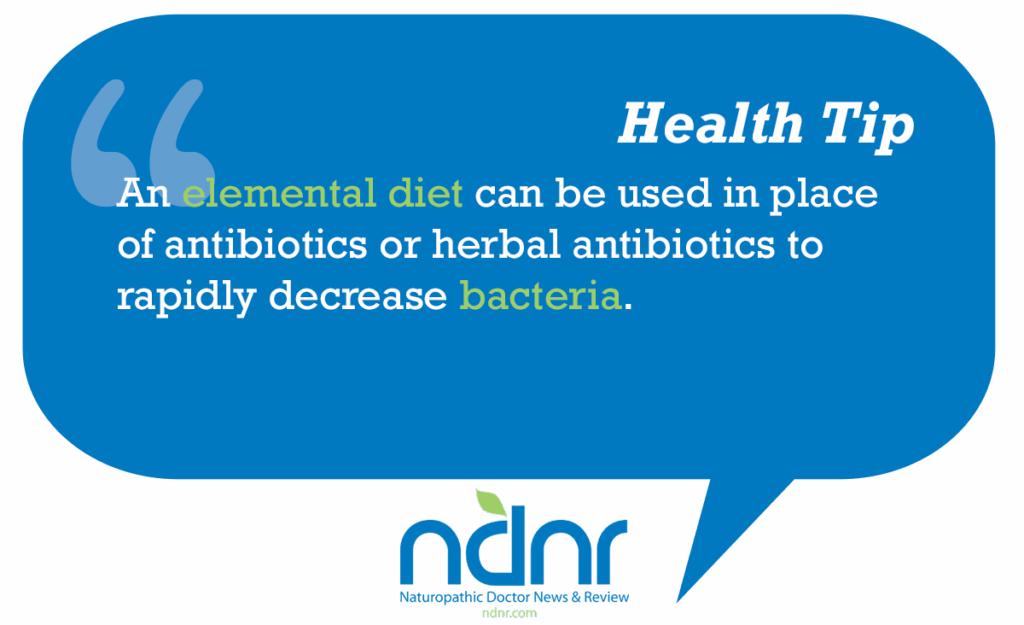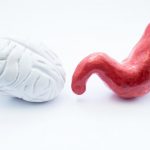Small Intestine Bacterial Overgrowth: Common but Overlooked Cause of IBS
Steven Sandberg-Lewis, ND
Allison Siebecker, ND, MSOM, LAc
Our experience has been that naturopathic approaches to irritable bowel syndrome (IBS) tend to be highly successful. Often, uncovering and removing hidden food intolerances, adding mindfulness to a rushed approach to meals, or restoring production of digestive acid or enzymes is the key to resolving IBS. But what about those cases in which bloating, abdominal pain, constipation, or diarrhea remain unchanged? After more life-threatening diagnoses are ruled out, where do you turn?
Small intestine bacterial overgrowth (SIBO) is a condition in which abnormally large numbers of commensal bacteria are present in the small intestine. SIBO is a common cause of IBS. In fact, it is involved in over half of the cases of IBS1 and was present in as high as 84% in a study2 using breath testing as the diagnostic marker. SIBO accounts for 37% of cases when endoscopic cultures of aerobic bacteria are used for diagnosis.3 Eradication of this overgrowth leads to a 75% reduction in IBS symptoms.4 Bacterial overgrowth leads to impairment of digestion and absorption and produces excess quantities of hydrogen or methane gas. These gases are not produced by human cells but are the metabolic product of fermentation of carbohydrates by intestinal bacteria. When commensal bacteria (oral, small intestine, or large intestine) multiply in the small intestine to the point of overgrowth, IBS is likely. Hydrogen or methane breath testing is the most widely used method of testing for this overgrowth. Stool testing has no value in diagnosing SIBO.
- Symptoms of SIBO include the following:
- Bloating or abdominal gas
- Abdominal pain and cramps
- Constipation, diarrhea, or alternation between the 2
- Heartburn
- Nausea
- Malabsorption (steatorrhea and anemia)
- Systemic symptoms (headache, joint pain, fatigue, and rosacea)
Other diseases associated with SIBO include hypothyroidism,5 lactose intolerance,6 Crohn disease,7 systemic sclerosis,8 celiac disease,9 chronic pancreatitis,10 diabetes with autonomic neuropathy,11 fibromyalgia and chronic regional pain syndrome,12 hepatic encephalopathy,13 nonalcoholic steatohepatitis,14 interstitial cystitis,15 restless leg syndrome,16 and acne rosacea.17
- In our practices, we have found that the following indicators increase the chances that a patient’s IBS is caused by SIBO:
- When a patient develops IBS following a bout of acute gastroenteritis
- When a patient reports dramatic transient improvement in IBS symptoms after antibiotic treatment
- When a patient reports worsening of IBS symptoms from ingesting probiotic supplements that also contain prebiotics
- When a patient reports that eating more fiber increases constipation and other IBS symptoms
- When a patient with celiac disease reports insufficient improvement in digestive symptoms even when following a gluten-free diet
- When a patient develops constipation-type IBS after taking opiates
- When a patient has chronic low ferritin levels with no other apparent cause
Mechanisms by Which Overgrowth Is Prevented
An important protective mechanism against SIBO is proper small intestine motility via the migrating motor complex18 because stasis promotes bacterial growth. Also key in prevention is gastric and pancreatic secretion.19 The use of proton pump inhibitors encourages overgrowth, especially of the hydrogen-producing type.20 We also suspect an important role for proper ileocecal valve function in preventing reflux of colonic bacteria into the small intestine.21 Proper bile salt secretion may also be protective, and there is evidence that SIBO can cause bile acid deconjugation, leading to fat malabsorption.22
How SIBO Causes the Symptoms of IBS
The definition of SIBO in culturing studies is 105 colony-forming units per milliliter of proximal jejunal aspiration.23 The bacteria that are most commonly overgrown are anaerobes (Bacteroides in 39%, Lactobacillus in 25%, and Clostridium in 20%) and aerobes (Streptococcus in 60%, Escherichia coli in 36%, Staphylococcus in 13%, and Klebsiella in 11%).23 In another study,20 the findings showed E coli in 37%, Enterococcus species in 32%, Klebsiella pneumoniae in 24%, and Proteus mirabilis in 6.5%.
Bloating is caused by bacterial production of hydrogen or methane gas. This leads to distension, pain, eructation, and flatulence. The quantity of gas may be extensive, causing distension and abdominal pain. The gases also affect motility, with hydrogen typically leading to diarrhea24 and methane causing constipation.25 The volume of the methane overproduction correlates with the severity of constipation.26 Macrocytic anemia and iron deficiency without anemia (low ferritin level) are caused by bacterial uptake of vitamin B12 or by iron-induced or diarrhea-induced malabsorption.27,28
Treatment of SIBO
In 2006, Dr Mark Pimentel29 shared his treatment algorithm for IBS with SIBO, which included the use of antibiotics, an elemental diet, or both. Our approach offers 2 additional options, namely, diet and herbal antibiotics (see figure online).
Diet
We recommend a special diet (specific carbohydrate diet or gut and psychology syndrome diet) for all patients with SIBO.30,31 Since bacteria use carbohydrates as their energy source and ferment them to gas, a low-carbohydrate diet can directly reduce symptoms by decreasing the amount of gas produced. Reducing carbohydrates may also reduce the overall bacterial load as the food supply shrinks, although formal studies to validate this are lacking. Many patients experience a rapid and significant decrease in symptoms after starting a SIBO diet. These diets decrease polysaccharides, oligosaccharides, and disaccharides by eliminating grains, starchy vegetables, lactose, sweeteners other than honey, and (in the beginning) beans. The specific carbohydrate diet has been reported to have an 84% success rate for inflammatory bowel disease.32 Diet alone has proven successful for infants and children, but for adults 1 or more of the other 3 treatment options are often needed, particularly in cases where diet needs to be very restricted to obtain symptomatic relief. Diet is also essential for prevention after SIBO treatment.
Elemental Diet
An elemental diet can be used in place of antibiotics or herbal antibiotics to rapidly decrease bacteria. Elemental diets are powdered predigested nutrients that are mixed with water and used in hospitals for various gastrointestinal disorders to give digestion a rest. The concept behind this treatment for SIBO is that the nutrients will be absorbed before having a chance to feed the bacteria, thus feeding the person but starving the bacteria. It is used in place of all meals, for 2 to 3 weeks, and has a success rate of 80% to 85%.33 Elemental diets are not protein powders or cleansing or detox formulas. They are available over the counter and are not covered by insurance, which can make this treatment course costly.
Antibiotics
The most studied and successful antibiotic for SIBO is rifaximin. It has a broad spectrum of activity and is nonabsorbable. Its nonabsorbability allows it to stay in the intestine, acting locally, and it is therefore less likely to cause systemic adverse effects commonly associated with standard absorbable antibiotics.34 Rifaximin has up to a 91% success rate35 and is given at 550 mg (3 times a day for 14 days).36 In addition, rifaximin has several unique benefits: it does not cause yeast overgrowth,34 it decreases antibiotic resistance in bacteria by reducing plasmids;37 antibiotic resistance to it does not develop (rendering it effective for retreatments);38 and it is anti-inflammatory, decreasing intestinal inflammatory cytokines and inhibiting nuclear factor–κB via the PXR gene.39 Rifaximin is best used for SIBO when hydrogen is present, but when methane gas is present, double therapy of rifaximin plus neomycin (500 mg twice daily) is more effective.40 Many gastroenterologists anecdotally prescribe metronidazole (250 mg 3 times a day) as an alternative to neomycin. Since different antibiotic regimens are recommended based on the gas type, breath testing is necessitated when considering this treatment.
Herbal Antibiotics
While there has been only one published study41 of herbal antibiotics in the treatment of SIBO, our experience is that they have effectiveness similar to that of antibiotics. We have used the following botanicals: Allium sativum, Hydrastis canadensis and other berberine-containing herbs, Origanum vulgare, Cinnamomum species, and Azadirachta indica. We have used these both as single agents and in various combinations at dosages that are at the upper end of label suggestions for 30 days. Specific single dosages we have used include allicin extract of garlic (450 mg twice daily or 3 times a day), goldenseal and berberine (5 g once daily in split dosage), emulsified oregano (100 mg twice daily), and neem (300 mg 3 times a day). Our breath testing data have validated the need for the longer treatment period of 30 days for herbal antibiotics compared with 14 days for antibiotics. We have also observed prolonged die-off reactions with this method, which can last for the duration of the treatment course. Studies on herbal antibiotics for SIBO are needed, particularly to identify botanicals effective in reducing methane.
Prevention of SIBO
SIBO is a disease that relapses because eradication itself does not always correct the underlying cause.42 The 2006 treatment algorithm by Pimentel29 includes 2 essential preventions, namely, diet and a prokinetic (motility agent). Our approach offers the following 3 optional additions: probiotics, hydrochloric acid, and brush border healing supplements. A key underlying cause of SIBO is thought to be deficiency of the migrating motor complex, which moves bacteria down into the large intestine during fasting at night and between meals.42,43 Prokinetics stimulate the migrating motor complex, symptomatically correcting this underlying cause. Prokinetics studied for SIBO include low-dose naltrexone (2.5 mg once daily or twice daily at bedtime),44 and low-dose erythromycin (50 mg at bedtime) or tegaserod (2-6 mg at bedtime).42 Tegaserod has a higher success rate for SIBO prevention than erythromycin42 but has been withdrawn from the US market for safety reasons. Prucalopride (1-4 mg at bedtime) is not yet available in the United States but is a safer alternative to tegaserod.45 A trial removal of the prokinetic after at least 3 months is suggested, but continued long-term use may be needed.29
A lower-carbohydrate diet is used in combination with a prokinetic to discourage a return of bacterial overgrowth by limiting the food they thrive on. Once the overgrowth is gone and small intestine damage has healed, the diet can be expanded beyond the strictness of the specific carbohydrate diet and the gut and psychology syndrome diet. At this point, the Cedars-Sinai diet,29 FODMAP diet,46 or a similar lower-carbohydrate diet may be adopted long term, as the patient tolerates.
In our practices, we have found that the following circumstances increase the chances for an unsatisfactory patient outcome:
Failure to continue treatment courses until SIBO is eradicated (negative breath test result or the patient is ≥90% better) (This crucial process of successive treatment is indicated by the long go-back arrow in the figure on the right side of the algorithm online.)
Failure to use double antibiotic therapy for methane producers (Methanogenic bacteria need different antibiotic treatment than hydrogen-producing bacteria.)
Failure to utilize breath testing to identify if the patient has SIBO, the type of gas he or she produces, and the overall level of gas (This information is necessary for diagnosis, treatment choice, duration, and prognosis.)
Failure to use a prokinetic immediately following treatment (Prokinetics along with diet are needed to prevent relapse of this commonly recurring condition.)
Failure to use a low-carbohydrate preventive diet following treatment (Diet and prokinetics are needed to prevent relapse of this commonly recurring condition.)
Failure to tailor diet to individual tolerances, with personal experimentation (No fixed diet can predict an individual’s complex bacterial, digestive, absorptive, immunological, and genetic circumstances; therefore, customizing
is necessary.)
Failure to identify underlying causative conditions (A recent study47 found that the following conditions led to a poor response to antibiotics: anatomical abnormalities, chronic narcotic use, Addison disease, scleroderma, colonic inertia, inflammatory bowel disease, and nonsteroidal anti-inflammatory drug–induced intestinal ulceration.)

Dr. Steven Sandberg-Lewis has been a practicing naturopathic physician since his graduation from National University of Natural Medicine (NUNM) in 1978. He has been a professor at NUNM since 1985, teaching a variety of courses but primarily focusing on gastroenterology and GI physical medicine. His clinic rotations are particularly popular among NUNM doctoral students. In addition to supervising clinical rotations he also maintains a part-time practice at 8Hearts Health and Wellness in Portland, Oregon.
He is a popular international lecturer at functional medicine seminars, presents webinars, writes articles for NDNR and the Townsend Letter and is frequently interviewed on issues of digestive health and disease. He is the author of the medical textbook Functional Gastroenterology: Assessing and Addressing the Causes of Functional Digestive Disorders, Second Edition, 2017, which is available at amazon.com. In 2010 he co-founded the SIBO Center at NUNM which is one of only four centers in the USA for Small Intestine Bacterial Overgrowth diagnosis, treatment, education and research. In 2014 he was named one of the “Top Docs” in Portland monthly magazine’s yearly healthcare issue and in 2015 was inducted into the OANP/NUNM Hall of Fame.
Within gastroenterology, he has special interest and expertise in inflammatory bowel disease (including microscopic colitis), irritable bowel syndrome (including post-infectious IBS), Small Intestine Bacterial Overgrowth (SIBO), hiatal hernia, gastroesophageal and bile reflux (GERD), biliary dyskinesia, and chronic states of nausea and vomiting.
Many of the patients referred to Dr. Sandberg-Lewis have digestive conditions that have defied diagnosis and effective resolution. Often these patients desire naturopathic treatment options in lieu of the courses of treatments they have previously undergone. He understands diseases of the gastrointestinal tract, but also can assess function and often find successful treatments to regain a balance in the digestive system.
Dr. Sandberg-Lewis lives in Portland with his wife, Kayle. His interests include mandolin, guitar and voice; cross country skiing; writing and lecturing.
 Allison Siebecker, ND, MSOM, LAc is a graduate of National College of Natural Medicine (Portland, Oregon), specializes in treating small intestinal bacterial overgrowth (SIBO) at the NCNM Clinic, and is currently writing a book on SIBO. Visit her educational SIBO website at www.siboinfo.com.
Allison Siebecker, ND, MSOM, LAc is a graduate of National College of Natural Medicine (Portland, Oregon), specializes in treating small intestinal bacterial overgrowth (SIBO) at the NCNM Clinic, and is currently writing a book on SIBO. Visit her educational SIBO website at www.siboinfo.com.
References
Peralta S, Cottone C, Doveri T, Almasio PL, Craxi A. Small intestine bacterial overgrowth and irritable bowel syndrome–related symptoms: experience with rifaximin. World J Gastroenterol. 2009;15(21):2628-2631.
Lin HC. Small intestinal bacterial overgrowth: a framework for understanding irritable bowel syndrome. JAMA. 2004;292(7):852-858.
Pyleris E, Giamarellos-Bourboulis EJ, Tzivras D, Koussoulas V, Barbatzas C, Pimentel M. The prevalence of overgrowth by aerobic bacteria in the small intestine by small bowel culture: relationship with irritable bowel syndrome. Dig Dis Sci. 2012;57(5):1321-1329.
Pimentel M, Park S, Mirocha J, Kane SV, Kong Y. The effect of a nonabsorbed oral antibiotic (rifaximin) on the symptoms of the irritable bowel syndrome: a randomized trial. Ann Intern Med. 2006;145(8):557-563.
Lauritano EC, Bilotta AL, Gabrielli M, et al. Association between hypothyroidism and small intestinal bacterial overgrowth. J Clin Endocrinol Metab. 2007;92(11):4180-4184.
Almeida JA, Kim R, Stoita A, McIver CJ, Kurtovic J, Riordan SM. Lactose malabsorption in the elderly: role of small intestinal bacterial overgrowth. Scand J Gastroenterol. 2008;43(2):146-154.
Klaus J, Spaniol U, Adler G, Mason RA, Reinshagen M, von Tirpitz CC. Small intestinal bacterial overgrowth mimicking acute flare as a pitfall in patients with Crohn’s disease. BMC Gastroenterol. 2009;9:e61. http://www.ncbi.nlm.nih.gov/pmc/articles/PMC2728727/. Accessed November 7, 2012.
Marie I, Ducrotté P, Denis P, Menard JF, Levesque H. Small intestinal bacterial overgrowth in systemic sclerosis. Rheumatology (Oxford). 2009;48(10):1314-1319.
Rubio-Tapia A, Barton SH, Rosenblatt JE, Murray JA. Prevalence of small intestine bacterial overgrowth diagnosed by quantitative culture of intestinal aspirate in celiac disease. J Clin Gastroenterol. 2009;43(2):157-161.
Mancilla AC, Madrid SAM, Hurtado HC, et al. Small intestine bacterial overgrowth in patients with chronic pancreatitis [in Spanish]. Rev Med Chil. 2008;136(8):976-980.
Ojetti V, Pitocco D, Scarpellini E, et al. Small bowel bacterial overgrowth and type 1 diabetes. Eur Rev Med Pharmacol Sci. 2009;13(6):419-423.
Goebel A, Buhner S, Schedel R, Lochs H, Sprotte G. Altered intestinal permeability in patients with primary fibromyalgia and in patients with complex regional pain syndrome. Rheumatology (Oxford). 2008;47(8):1223-1227.
Gupta A, Dhiman RK, Kumari S, et al. Role of small intestinal bacterial overgrowth and delayed gastrointestinal transit time in cirrhotic patients with minimal hepatic encephalopathy. J Hepatol. 2010;53(5):849-855.
Shanab AA, Scully P, Crosbie O, et al. Small intestinal bacterial overgrowth in nonalcoholic steatohepatitis: association with Toll-like receptor 4 expression and plasma levels of interleukin 8. Dig Dis Sci. 2011;56(5):1524-1534.
Weinstock LB, Klutke CG, Lin HC. Small intestinal bacterial overgrowth in patients with interstitial cystitis and gastrointestinal symptoms. Dig Dis Sci. 2008;53(5):1246-1251.
Weinstock LB, Walters AS. Restless legs syndrome is associated with irritable bowel syndrome and small intestinal bacterial overgrowth. Sleep Med. 2011;12(6):610-613.
Parodi A, Paolino S, Greco A, et al. Small intestinal bacterial overgrowth in rosacea: clinical effectiveness of its eradication. Clin Gastroenterol Hepatol. 2008;6(7):759-764.
Husebye E. The patterns of small bowel motility: physiology and implications in organic disease and functional disorders. Neurogastroenterol Motil. 1999;11(3):141-161.
Bures J. Small intestinal bacterial overgrowth syndrome. World J Gastroenterol. 2010;16(24):2978-2990.
Pyleris E, Giamarellos-Bourboulis EJ, Tzivras D, Koussoulas V, Barbatzas C, Pimentel M. The prevalence of overgrowth by aerobic bacteria in the small intestine by small bowel culture: relationship with irritable bowel syndrome. Dig Dis Sci. 2012;57(5):1321-1329.
Machado WM, Miranda JR, Morceli J, Padovani CR. The small bowel flora in individuals with cecoileal reflux. Arq Gastroenterol. 2008;45(3):212-218.
Williams C. Occurrence and significance of gastric colonization during acid-inhibitory therapy. Best Pract Res Clin Gastroenterol. 2001;15(3):511-521.
Bouhnik Y, Alain S, Attar A, et al. Bacterial populations contaminating the upper gut in patients with small intestinal bacterial overgrowth syndrome. Am J Gastroenterol. 1999;94(5):1327-1331.
Pimentel M, Kong Y, Park S. Breath testing to evaluate lactose intolerance in irritable bowel syndrome correlates with lactulose testing and may not reflect true lactose malabsorption. Am J Gastroenterol. 2003;98(12):2700-2704.
Kunkel D, Basseri RJ, Makhani MD, Chong K, Chang C, Pimentel M. Methane on breath testing is associated with constipation: a systematic review and meta-analysis. Dig Dis Sci. 2011;56(6):1612-1618.
Chatterjee S, Park S, Low K, Kong Y, Pimentel M. The degree of breath methane production in IBS correlates with the severity of constipation. Am J Gastroenterol. 2007;102(4):837-841.
DiBaise JK. Nutritional consequences of small intestinal bacterial overgrowth. Prac Gastroenterol. 2008;69:15-28.
Alonso Cotoner C, Casellas Jordá F, Chicharro Serrano ML, de Torres Ramírez I, Malagelada Benaprés JR. Iron deficiency: not always blood losses [in Spanish]. An Med Interna. 2003;20(5):227-231.
Pimentel M. A New IBS Solution. Sherman Oaks, CA: Health Point Press; 2006:90.
Gottschall E. Breaking the Vicious Cycle. Baltimore, MD: Kirkton Press Ltd; 1994.
Campbell-McBride N. Gut and Psychology Syndrome. Cambridge, England: Medinform Publishing; 2004.
Nieves R, Jackson RT. Specific carbohydrate diet in treatment of inflammatory bowel disease. Tenn Med. 2004;97(9):407.
Pimentel M, Constantino T, Kong Y, Bajwa M, Rezaei A, Park S. A 14-day elemental diet is highly effective in normalizing the lactulose breath test. Dig Dis Sci. 2004;49(1):73-77.
Scarpignato C, Pelosini I. Experimental and clinical pharmacology of rifaximin, a gastrointestinal selective antibiotic. Digestion. 2006;73(suppl 1):13-27.
Lombardo L, Foti M, Ruggia O, Chiecchio A. Increased incidence of small intestinal bacterial overgrowth during proton pump inhibitor therapy. Clin Gastroenterol Hepatol. 2010;8(6):504-508.
Pimentel M, Lembo A, Chey WD, et al; TARGET Study Group. Rifaximin therapy for patients with irritable bowel syndrome without constipation. N Engl J Med. 2011;364(1):22-32.
Debbia EA, Maioli E, Roveta S, Marchese A. Effects of rifaximin on bacterial virulence mechanisms at supra- and sub-inhibitory concentrations. J Chemother. 2008;20(2):186-194.
Yang J, Lee HR, Low K, Chatterjee S, Pimentel M. Rifaximin versus other antibiotics in the primary treatment and retreatment of bacterial overgrowth in IBS. Dig Dis Sci. 2008;53(1):169-174.
Mencarelli A, Renga B, Palladino G, et al. Inhibition of NF-κB by a PXR-dependent pathway mediates counter-regulatory activities of rifaximin on innate immunity in intestinal epithelial cells. Eur J Pharmacol. 2011;668(1-2):317-324.
Low K, Hwang L, Hua J, Zhu A, Morales W, Pimentel M. A combination of rifaximin and neomycin is most effective in treating irritable bowel syndrome patients with methane on lactulose breath test. J Clin Gastroenterol. 2010;44(8):547-550.
Logan AC, Beaulne TM. The treatment of small intestinal bacterial overgrowth with enteric-coated peppermint oil: a case report. Altern Med Rev. 2002;7(5):410-417.
Pimentel M, Morales W, Lezcano S, Sun-Chuan D, Low K, Yang J. Low-dose nocturnal tegaserod or erythromycin delays symptom recurrence after treatment of irritable bowel syndrome based on presumed bacterial overgrowth. Gastroenterol Hepatol (N Y). 2009;5(6):435-442.
Pimentel M. An evidence-based treatment algorithm for IBS based on a bacterial/SIBO hypothesis: part 2. Am J Gastroenterol. 2010;105(6):1227-1230.
Ploesser J, Weinstock LB, Thomas E. Low dose naltrexone: side effects and efficacy in gastrointestinal disorders. Int J Pharm Compounding. 2010. http://www.gidoctor.net/client_files/file/Naltrexone-Side-Effects-and-Efficacy-in-GI-Disorders.pdf. Accessed November 7, 2012.
Manabe N, Rao AS, Wong BS, Camilleri M. Emerging pharmacologic therapies for irritable bowel syndrome. Curr Gastroenterol Rep. 2010;12(5):408-416.
Gibson PR, Shepherd SJ. Evidence-based dietary management of functional gastrointestinal symptoms: the FODMAP approach. J Gastroenterol Hepatol. 2010;25(2):252-258.
Chou JY, Tabrizi R, Pimentel M, Sokol T. S1326 presumed IBS subjects with short remission after antibiotic therapy often have secondary causes for their symptoms. Gastroenterology. 2010;138(5)(suppl 1):S-229. http://www.gastrojournal.org/article/S0016-5085(10)61042-6/abstract. Accessed November 7, 2012.









